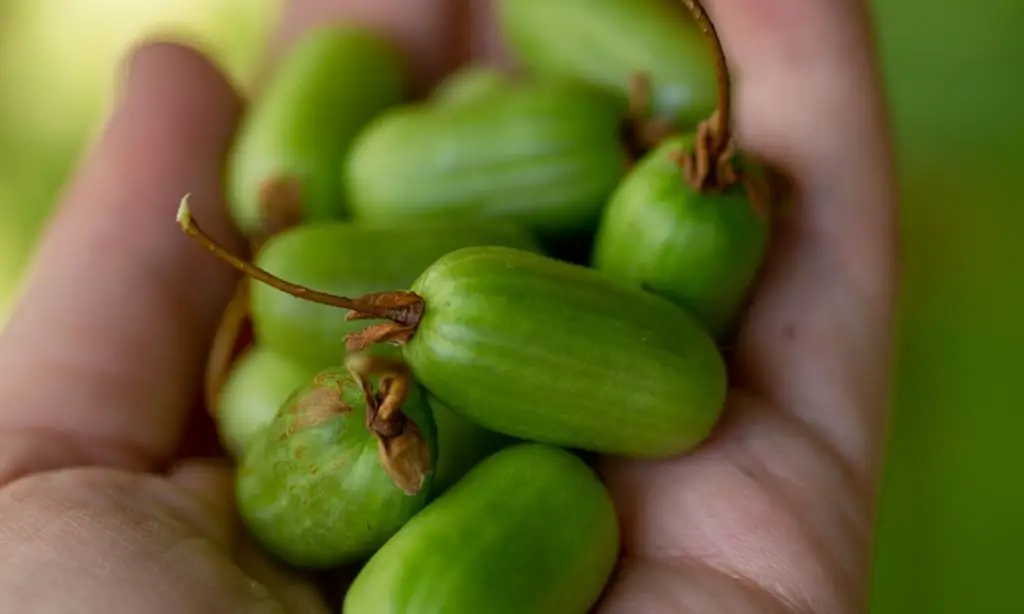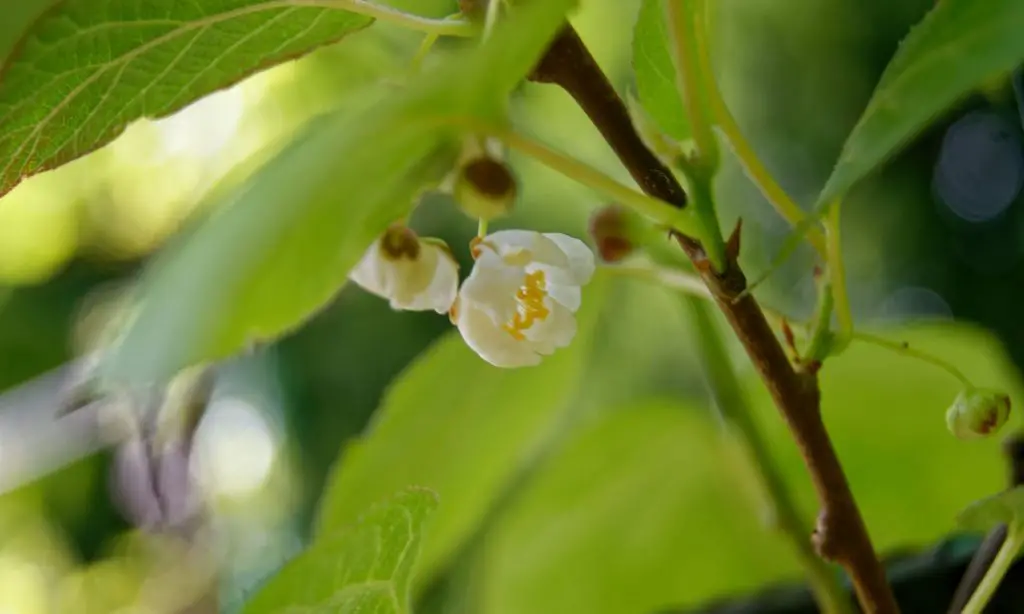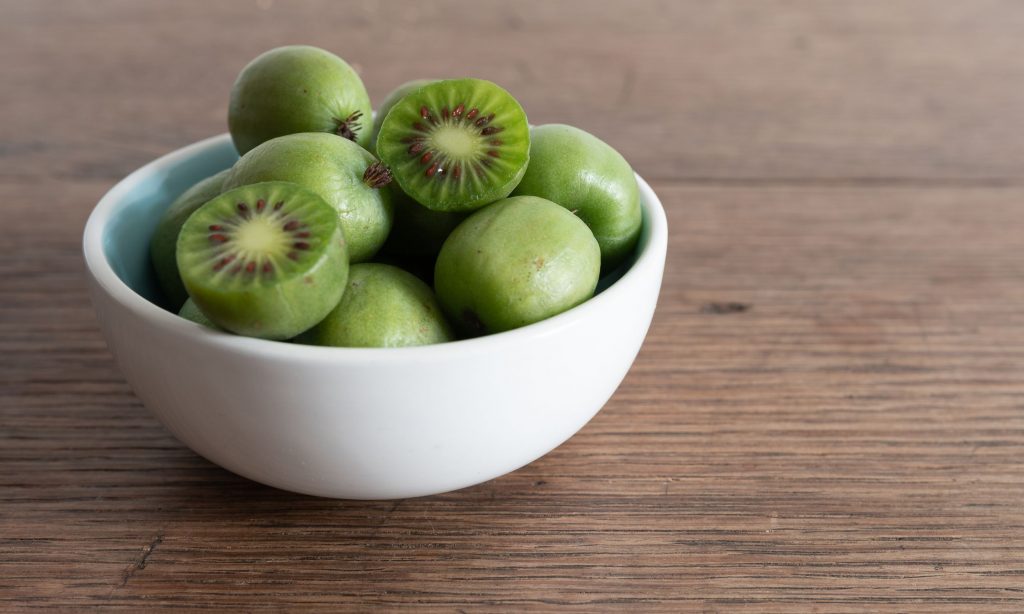How to Grow Hardy Kiwi in Your Backyard Orchard
Imagine a fruit with kiwi flavor, but sweeter, grape-sized and fuzz-free. Such a thing exists and we can grow it in our backyards with ease. This fruit is called hardy kiwi.
People really like the taste of kiwi. It’s a different fruit. And with hardy kiwi, you can just pop it in your mouth without peeling because it doesn’t have the fuzzy skin. Kiwi is not only delicious, but nutritious, with more vitamin C than oranges, more potassium than bananas, and a healthy dose of folate, copper, fiber, vitamin E and lutein. For USDA zone 7 or above dwellers, there are several kiwi plants suited to your zones.
Like many fruits, hardy kiwi needs full sun and consistent moisture to thrive. Give your kiwi rich and well-drained soil and you’ll be rewarded with vines that romp and sweet fruit.
Growing hardy kiwi vines requires extensive space. They can grow over 20 feet (6 m.) tall and should be planted about 10 to 18 feet (3-5 m.) apart. Since hardy kiwis are vigorous growers, it’s important to provide some strong trellising to support them, both vertically and horizontally.
Once kiwi is mature enough to make fruit, you’ll notice that the fruit reach full-size by midsummer. Kiwi won’t ripen to its full sweetness until late summer – sometimes into September. Kiwi will continue to ripen off the vine, and will keep longer if picked just a bit before ripe.
Interested in growing your own Hardy Kiwis? Read on to find out about hardy kiwi vines.
Disclosure: Some of the links below are affiliate links, meaning, at no additional cost to you, I will earn a commission if you click through and make a purchase.

What is a Hardy Kiwi-
The kiwi we are most familiar with is native to China and won’t tolerate temperatures lower than 10 degrees. Hardy Kiwi can be grown as far north as zone 6. But a late spring cold spell can damage some tender new growth but hardy kiwi grows so quickly, it can compensate for the loss. Although different from traditional fuzzy kiwi in size and characteristics, they are equally delicious and packed with nutrition.
To become productive hardy kiwi vines, whether in gardens or pots, must be planted with at least one male for every six females.
Unlike the brown fuzzy variety in the grocery store, the fruits of hardy kiwi fruits are smaller, like the size of a large grape, and sometimes turn a rosy hue. They have tender, edible skin, are full of Vitamin C, and are highly aromatic.
Hardy kiwi is an excellent fit for backyard growing. The vine grows very quickly, is attractive and, importantly, it’s not super fussy. Like raspberries, strawberries and blueberries, kiwi does not require the treatment regiment that might be required to produce vigorous and cosmetically appealing stone fruits like peaches.

Caring for Your Hardy Kiwi Vine-
Don’t fertilize your vines right away, but in the spring following the first planting I suggest fertilizing your kiwi vines with compost tea. We make compost tea with our worm castings, it is super easy and can be done in any size yard/garden. Learn more about compost tea HERE and learn more about worm composting HERE.
Like many fruits, hardy kiwi needs full sun and consistent moisture to thrive. Give your kiwi rich and well-drained soil and you’ll be rewarded with vines that romp and sweet fruit. Kiwi does not like wet soil or drought. Roots can be damaged if the roots are too wet. Drought will stress the plant and effect the size of the fruit. Prolonged lack of water can cause fewer blooms early in the season and fruit to drop before it’s ripen later in the season. Deep soakings rather than constant shallow watering during dry spells will help produce the best fruit. Keep dust levels low around the plants and encourage beneficial insects like lacewing or assassin bugs.
Growing hardy kiwi vines requires extensive space. They can grow over 20 feet (6 m.) tall and should be planted about 10 to 18 feet (3-5 m.) apart. Since hardy kiwis are vigorous growers, it’s important to provide some strong trellising to support them, both vertically and horizontally. They need sturdy vertical support for the trunk and wood or wire support for side branches.
Typically, kiwi is grown on T-shaped structure several feet off the ground for ease of picking. Create a trunk by pruning off laterals from the main vine in the dormant season along the vertical part of the T structure. Gently direct the main vine to the top of the T. Attach vines to supports to prevent breakage.
Pruning Your Hardy Kiwi-
Dormant season pruning will help your hardy kiwis stay healthy. However, hardy kiwi growing in the first year requires consistent pruning to train the plant to grow straight and upward. Unlike many other plants, your hardy kiwi vines will also need frequent pruning throughout the summer. The terminal growth needs to be cut back to four to six leaves beyond the last flower. Also, any shoots that may appear on the older wood and trunk, as well as any entangled shoots, should be removed in the summer.
Propagating Hardy Kiwi-
Propagating hardy kiwi from cuttings is the preferred method used, as the cutting yields the same-sex offspring as the parent plant. Gardeners growing kiwi for fruit can easily select both male and female cuttings, should they already know the sex of the parent.
Here’s how to propagate hardy kiwi vine from cuttings:
- Gather gloves, gardening shears, a 4-inch pot with a mix of potting soil and vermiculite (we use sand), and rooting hormone powder.
- During a regular summer pruning, select a 5- to 8-inch softwood cutting, 1/2 inch in diameter, and snip it just below the leaf node.
- Remove the leaves from the lower part of the cutting, leaving just one set at the top. Poke a hole in the potting medium.
- Dip the cutting into the rooting powder and place one inch of it into the hole; backfill it to set.
- Water the pot, let it drain completely, and then relocate it to a warm, sunny indoor area (preferably a greenhouse).
- Rooting should occur in six to eight weeks. Transplant your cutting outside when it is 4 feet tall.
Overwintering Hardy Kiwi-
Most varieties of hardy kiwi can withstand winter temperatures as low as -25 degrees Fahrenheit, still it’s necessary to protect them, should you want a fruitful harvest. Young kiwi vines that are in the ground need only a little extra care. Simply wrap the trunks with frost protection or mound soil and leaves at its base.
After a few years of overwintering, your plant should grow hardy enough to withstand cold temperatures without care. In the spring, make sure to protect new shoots from late-season frosts with a cover or blanket, as hardy kiwi sets fruit on the current season’s growth. Any damage to this growth can affect your harvest.
Common Pest and Disease-
Hardy kiwi vine can suffer from both pests and disease infestation. Keep an eye out for critters—like the Japanese beetle, leafroller caterpillars, root-knot nematode, and snails—which may feed on the fruit. Cover your crop during the fruiting season to keep pests away.
Infestations from bugs, like thrips and two-spotted spider mites, rarely kill the plant, but can be treated with soap and water or a neem oil spray. Avoid the use of pesticides on fruiting plants, as their use can pose harm to yourself, as well as the plant’s pollinators.
Hardy kiwi can also fall victim to fungal diseases, like phytophthora crown and root rot, when neglected. Both conditions present as reddish brown roots and crowns, and can be prevented by proper soil moisture management. Botrytis fruit rot can also affect the fruit of your kiwi and cause grey mold and shriveled fruit. There is no treatment for this disease, only prevention, and fungicide use is harmful to those who eat the fruit.

When to Harvest your Hardy Kiwi’s-
Hardy Kiwi takes a few years to produce fruit. Depending on the age of the vines you purchase, it could be one to three years before fruit is made. Yields will increase after the first year. Male plants need to be older than the females to perform their function.
Once kiwi is mature enough to make fruit, you’ll notice that the fruit reaches full-size by midsummer. Kiwi won’t ripen to its full sweetness until late summer – sometimes into September. Kiwi will continue to ripen off the vine, and will keep longer if picked just a bit before ripe. If picked too soon, the full sweetness won’t develop. To test, pick a few, allow them to ripen on a counter or in a window sill for a few days. If the kiwi becomes sweet and soft, it’s time to harvest. Storing kiwi in a refrigerator will keep them from ripening. Take out and ripen kiwi as needed.
Kiwi that’s ripened on the vine is delicious, too, but it won’t store as long. All kiwi should be picked before the first frost.
Growing Hardy Kiwi in Pots/Containers-
Grow your kiwi in a large container—a five-gallon bucket drilled with drain holes works well—and provide a back support or trellis behind it. Use a well-drained, slightly acidic soil that contains perlite or pumice, and amended it with organic fertilizer, such as compost or manure. Dig a hole in the soil and plant your kiwi so that the plant’s roots are level with the soil line, backfill the hole to cover the roots, and relocate your plant to a sunny outdoor area. As your kiwi begins to grow, use ties to secure it to the back structure. Water it thoroughly throughout the growing season, and refresh the soil each year.
Hardy kiwi is a unique and delicious fruit that can be grown in many parts of the United States. The vines are hardy and easy to care for, and the fruit can be harvested late in the fall or early winter. If you’re interested in growing your own hardy kiwis, we have all the information you need to get started right here on our blog. And if you’ve already had success with this fruit, let us know about it in the comments below – we love hearing from our readers!
